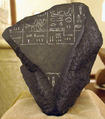|
Mast (hieroglyph)
The ancient Egyptian Mast hieroglyph is one of the oldest language hieroglyphs from Ancient Egypt. It is used on a famous label of Pharaoh Den of the First dynasty, but forms part of the location hieroglyph: Emblem of the East. Nectanebo II's obelisk uses the Mast hieroglyph when describing the construction of his obelisk; in a S-Egyptian emphatic word construct he adds a vertical S, the folded cloth, Gardiner no. S29,
The Ship's Mast hieroglyph is used as a triliteral phonetic hieroglyphic to represent the sound sequence ꜥḥꜥ, which means "to stand erect", or "to stand vertical"; its use is extensive throughout the language history, and hieroglyphic tomb reliefs and story-telling of Ancient Egypt. It is possibly a forerunner hieroglyph kh3 [clarification needed], the sun rising upon the horizon. In the 198 BC Rosetta Stone, the ship's mast hieroglyph has the unique usage in the final line of the Ptolemy V decree: the mast is used twice-(adjective, verb):
See alsoWikimedia Commons has media related to Mast (hieroglyph).
References
|




